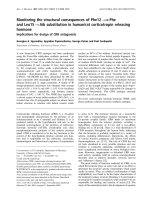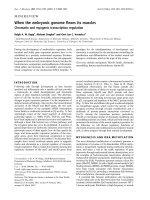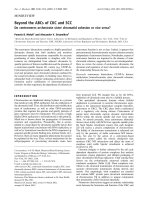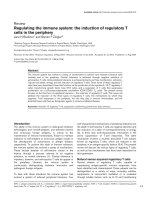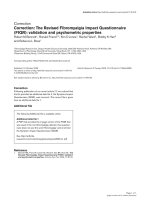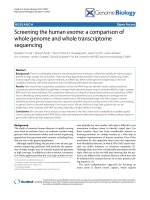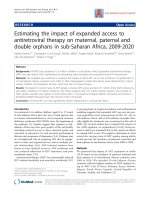Báo cáo y học: " And the second shall be first" ppsx
Bạn đang xem bản rút gọn của tài liệu. Xem và tải ngay bản đầy đủ của tài liệu tại đây (144.02 KB, 3 trang )
Genome Biology 2007, 8:103
Comment
And the second shall be first
Gregory A Petsko
Address: Rosenstiel Basic Medical Sciences Research Center, Brandeis University, Waltham, MA 02454-9110, USA.
Email:
Published: 26 February 2007
Genome Biology 2007, 8:103 (doi:10.1186/gb-2007-8-2-103)
The electronic version of this article is the complete one and can be
found online at />© 2007 BioMed Central Ltd
It’s one of the most famous photographs in history - almost
iconic. It shows a jubilant US President Harry Truman, fresh
from his unexpected victory in the Presidential election of
1948 over New York Governor Thomas Dewey, holding up
that morning’s edition of the Chicago Daily Tribune, whose
headline boldly - and incorrectly - proclaims “Dewey defeats
Truman” (Figure 1).
When Truman went to bed in the Elms Hotel in Excelsior
Springs, Missouri, on the night of 2 November 1948, he was
losing the election, as most of the polls predicted he would.
In its haste to get the scoop on its rival papers, the Tribune
printed an early edition with a headline giving the expected
result based on the early returns. When Truman woke the
next morning, he learned he had in fact won, so he took the
train to Washington, DC that same day. On a short stop in
St Louis, he was presented with one of the “Dewey defeats
Truman” papers while on the back platform of the train. It
was at this moment that the now famous photo of Truman
holding up the paper was taken.
I first saw that picture in the 1960s, when I worked as a
stringer for a big-city newspaper. My editor had it framed on
the wall of his office. And underneath it, in his own hand, he
had placed these words: “It’s nice to be first, but it’s better to
be right.”
I was reminded of this photo when I read about the recent
retraction by a group from Scripps Research Institute in San
Diego, California, of five papers describing protein crystal
structures and their corresponding atomic coordinate sets
that had been published in Science, Molecular Biology, and
Proceedings of the National Academy of Sciences (see
Miller: A scientist’s nightmare: software problem leads to
five retractions. Nature 2006, 314:1856-1857 and Chang et
al.: Retraction. Science 2006, 314:1875). Apparently, a
computer program used by the group had changed the sign
of the anomalous differences, which are the differences
between X-ray intensity data measured with the X-ray beam
hitting the front and back of the crystal, in data sets collected
for five different membrane protein crystal structures.
Anomalous differences can be a powerful aid to solving the
structure of a protein by X-ray crystallography. The head of
the lab states that “…our MsbA structures were incorrect in
both the hand of the structure and the topology. Thus, our
biological interpretations based on these inverted models for
MsbA are invalid. …The error in the topology of the original
MsbA structure (published in 2001) was a consequence of
the low resolution of the data as well as breaks in the
electron density for the connecting loop regions.
Unfortunately, the use of the multicopy refinement
procedure still allowed us to obtain reasonable refinement
values for the wrong structures.”
The problem might have gone unrecognized for some time
longer had Kaspar Locher (Swiss Federal Institute of
Technology, Zurich) not determined the correct structure of
Figure 1
Harry Truman after his unexpected victory over Thomas Dewey in the
Presidential election of 1948 with the Chicago Daily Tribune, whose early
edition boldly and incorrectly proclaimed Dewey’s victory.
a related protein (Locher and Dawson: Nature 2006, 443:
180-185). Locher’s structure was completely consistent with
the body of biochemical and biophysical data on that class of
protein (the so-called ABC transporter superfamily), in
contrast to the structures generated at Scripps, which were
notably inconsistent.
Their mistake has consequences beyond the damage to the
unfortunate young investigator and his team. For five years,
other labs have been interpreting their biophysical and
biochemical data in terms of the wrong structures. A number
of scientists have been unable to publish their results
because they seemed to contradict the published X-ray
structures. I personally know of at least one investigator
whose grant application was turned down for funding
because his biochemical data did not agree with the
structures. One could argue that an entire sub-field has been
held back for years due to the inordinately persuasive power
of the pretty pictures that structural biology produces.
In retrospect, there were a number of serious red flags in the
work (a major one being the low resolution of the first
structure determination, 4.5 Å, a resolution at which it is all
too easy to make major mistakes in interpretation). But why
on earth Science, which published the original paper, and its
referees didn’t worry from the get-go about the failure of the
structure to explain what was already known about this type
of protein is beyond me. In an era when experimental details
are relegated to ‘Supplemental material’, especially in the
vanity journals, and when canned software makes it easy for
people without a deep understanding of the method to
determine structures and to referee the structure papers of
others, it may be too much to expect that technical errors
can be caught reliably, but that isn’t the best criterion to use
for the correctness of a protein structure anyway. As my
Brandeis colleague Chris Miller notes, in a pithy letter on the
retractions, “This case highlights the dangers of ignoring
biochemical results, conventional but logically solid” (Miller:
Science 2007, 315:459). I’ve said it before, but it bears
repeating: the only reliable test for the correctness of a
macromolecular structure is if it makes sense in terms of
what is already known about the molecule. If it is consistent
with the body of experimental data about the protein or its
family, it is probably right. If it is not consistent, it is very
likely wrong.
But it seems to me that in all the hoopla about this incident,
another point that needs to be made has gotten lost. The
hero of the story, of course, is Kaspar Locher, who was not
deterred from completing and publishing his own structure
even though he had apparently been scooped five years
previously. That was easier for him in the field of membrane
proteins, with rather few structures compared with their
soluble brethren and where even structures of closely related
ones are perceived as worthwhile. Imagine how much more
difficult it would be for someone to decide to carry on in the
case of an area that is not as hot? Yet if this story should
convince us of anything, it is of the value of the second
report, and the danger of overvaluing the first. Journals like
Nature, Science and Cell place so much importance on being
the first to publish something of general interest that they
create enormous pressure on people to rush to print. No
structural biologist would ordinarily settle for 4.5 Å
resolution and expect to get things right unless they felt the
need to beat their competitors and to have their work
published in a journal with as high a profile as possible.
I think that feeling is often self-defeating, as it clearly was
here. The high-profile journals don’t ipso facto do the best
job of reviewing manuscripts - in fact, in my experience, they
are often a little worse than the so-called trade journals. And
very often the first report of something is incomplete, hasty
in its judgments, and not nearly as informative as the second
paper, which has the advantage not only of calmer
consideration, but also has the first paper to use for target
practice. But try telling that to students and post-docs, who
clamor to have their work sent to the vanity journals, even
when it is patently too specialized. And try telling it to the
editors of those journals, who, one worries, may have come
to value priority over everything else.
How did we get to this state? It makes no sense to me,
because in science what we are supposed to value above all
else is reproducibility. The report that confirms a finding
should, therefore, be considered of equal value to the one
that first announces it, but somehow we have either
forgotten that fact or succumbed to a collective frenzy for
high-profile publications.
We’re all guilty of feeding this beast. I have sat on post-
doctoral fellowship panels and listened to people say of
candidate X: “She has published five papers from her
graduate work, two in Nature and one in Cell”, as if that fact
alone is all that needs to be said about the quality of the
applicant. Frequently, stating where the papers were
published is a surrogate for actually having read them. I’m
ashamed to say I’ve done that myself. Does being the first
into print mean more than publishing the best paper, the
most thoughtful paper, or a more useful paper on a subject?
Does content mean so little any more?
Right now the field of genomics is somewhat insulated from
this problem. Nearly all the major genome sequences have
been either collaborative or solo efforts. The one example of
fierce competition, to be the first to sequence the human
genome, resulted in an arranged dead heat, and as far as we
know didn’t affect the quality of the finished product. But as
the $1,000 genome sequence edges closer to reality, and as
the supply of really interesting organisms whose genomes
have yet to be sequenced shrinks, you can bet there will be
more races, more pressure to get there first, and more
cutting of corners along the way. When that happens, will we
103.2 Genome Biology 2007, Volume 8, Issue 2, Article 103 Petsko />Genome Biology 2007, 8:103
remember that all too often the first report is sketchy,
superficial in its analysis, and more prone to error? Will we
value, as much as we should, the second report, which is
often more thoughtful, more useful, and is essential to the
scientific process of validation and self-correction?
I think that’s the real lesson of the unfortunate events at
Scripps. And it’s a lesson that all of us - every student,
every post-doc, every faculty member, every journal editor,
every pharmaceutical executive and biotech science officer,
every referee, every grants administrator, every scientist,
everywhere - would do well to remember.
So I’m going to frame a copy of that Harry Truman photo,
and put it on the wall in my office - or maybe in my lab. And
underneath it, in my own hand, I’m going to write: “It’s nice
to be first, but it’s better to be right.”
Genome Biology 2007, Volume 8, Issue 2, Article 103 Petsko 103.3
Genome Biology 2007, 8:103
